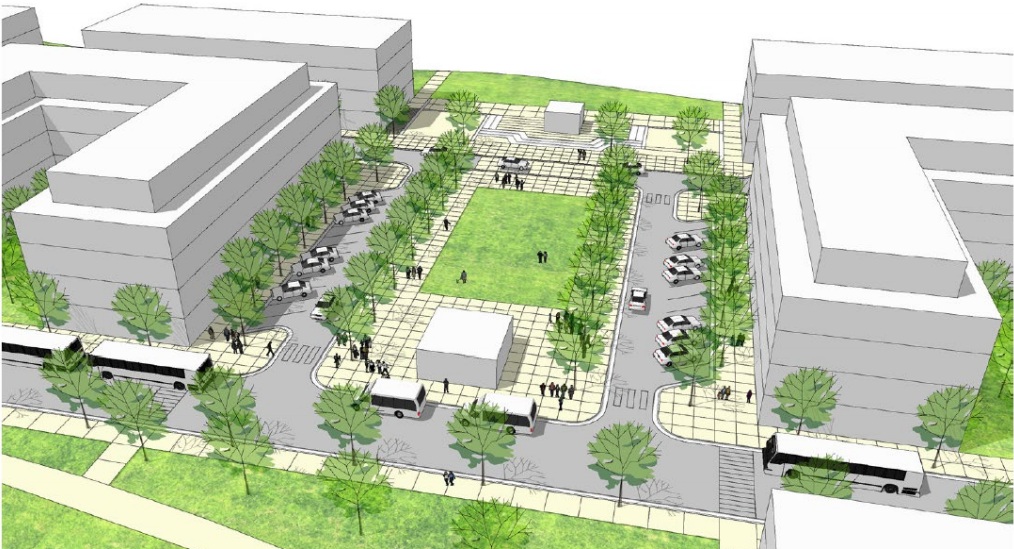Is the county foisting the Seneca site onto the city?
The county and city appear to be on separate pages when it comes to a key component of Destination Medical Center transit planning.
At Thursday’s meeting of the DMC Corporation Board, Rochester Mayor Kim Norton became frustrated at times as she discussed a county-led proposal to convert the former Seneca property into a mobility hub.
At issue is whether the county got ahead of the city’s transportation studies when in February it announced plans to buy the 11-acre Seneca site.
Speaking in her dual role as a DMCC board member, the mayor suggested she had been caught off-guard by the county’s real estate maneuvering.
“I guess I would like to say, what are our fallbacks going to be if this breaks down?” asked the mayor. “What are our alternatives and how are we going to work that into the discussion of transit and transportation?”
News of the $5.6 million deal with Seneca came just 10 days after the DMCC board approved Graham Park — located adjacent to the shuttered Seneca factory — as the future home of one of two mobility hubs, also referred to as transit villages. The county board signed off on the purchase soon after.
Example of a multi-use mobility hub via the DMC packet
At the time, commissioners described the purchase as a strategic move for the county. DMC and city officials, however, had been largely left in the dark about the county’s intentions, according to sources we spoke with.
City Council Member Nick Campion, who serves on the board alongside Norton, said he was “a little bit struck” about how the process played out. He noted that while the DMCC board did commit to doing a transit site in the Graham Park area, it never agreed to use the Seneca land specifically.
“I have some significant concerns here that I am basically hearing, ‘we’re committed financially to purchasing this property through Seneca,’ and the [county] board is adamant that this is where the transit hub is going,” said Campion.
County Chair Jim Bier, also a member of the DMCC board, acknowledged there have been some differences in opinion during his meetings with representatives from the city and DMC Economic Development Agency.
Bier, however, said the financial considerations would be similar whether the city chose to pursue either Graham Park or the Seneca land.
“If the city wants to own the underlying property, I don’t see a lot of difference in the value of the Seneca property or Graham Park,” said Bier. “We would expect to be compensated one way or another.”
The choice to endorse the Seneca site for the mobility hub, Bier said, stems from the fact that the county feels the bulk of Graham Park “should be preserved as a community greenspace.” The county is in the process of trying to redevelop the park with a new arena and other amenities.
“It’s the intent, and it has been the intent, of the county board to purchase that Seneca property for the bulk of the transit mobility hub,” said Bier.
The county is slated to close on the property on June 28.
Given the tight deadline, Campion said it was important to move quickly in determining whether the Seneca site makes sense as a transit hub.
“I don’t want the county left in a position where we’re not able to afford to put a transit hub there, given our acquisition price, and yet they still have to go forward with the acquisition,” said Campion.
Proposed circulator route / DMC planning documents
The southeast mobility hub would be one of two anchoring sites along a 3.5 mile circulator route connecting key stops downtown. The other transit village — a name for a parking area that also includes added components like housing and retail — is the Mayo West Lot near Cascade Lake.
Under plans adopted as a result of DMC, the circulator would utilize bus rapid transit (BRT) — a mode of transportation that feels more like light rail than a typical bus system. Unlike standard buses, BRT vehicles run more frequently and faster, and use their own on-street transit lanes.
The goal is to combine the efficiencies of a better transit system with the conveniences of transit villages to reduce congestion downtown as the city embarks on what is anticipated to be an unprecedented period of growth.
“If we’re going to capture people on the outskirts of town, which is going to be really important for us to not have this city overwhelmed with traffic jams and parking ramps, we’ve really got to create an amenity,” R.T. Rybak, the DMCC board chair, said of the mobility hubs.
That means, according to Rybak, “figuring out, first off, what is the fastest route? Second, what is the one that has the best impact on development? And third, how do we give people an experience?”
Rendering of a bus rapid transit system
Plans for rail back on track?
Conversations around light rail appear to be picking up steam.
During Thursday’s conversation on transportation, Mayor Norton re-introduced the idea of rail, an option that had been put on the back burner ever since DMC transit studies recommended using the BRT system.
(We are talking about a transit line connecting points within the city; not to be confused with the concept of a high-speed rail connecting Rochester with the Twin Cities. That plan appears to be dead, for now anyways.)
“One of the things from the very beginning in the talk about DMC that excited me about transformational changes in the community had to do with rail,” said Norton, who co-authored the original 2013 legislation.
“I do hope we take that seriously,” she added. “We are trying to create a community for the future, and we need to do it in a way that will draw people here [and] provide the services that are here.”
In one of the rare moments of unity on the topic of transportation, Bier agreed with Norton that light rail should be reconsidered. He brought up the possibility of leveraging the existing rail line that runs through the city’s new downtown parking ramp.
“I think [rail] should be incorporated,” he said.
Given that Norton feels strongly about the issue, Rybak, a former mayor himself, recommended re-opening the idea for discussion.
“I think when a new mayor gets elected with a strong point of view, we should react to it,” said Rybak.
Follow Sean on Twitter.
Cover: Graham Park, to the left, and the Seneca site, bottom right / Google Earth











